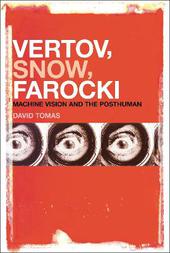
|
Vertov, Snow, Farocki: Machine Vision and the Posthuman
Hardback
Main Details
| Title |
Vertov, Snow, Farocki: Machine Vision and the Posthuman
|
| Authors and Contributors |
By (author) David Tomas
|
| Physical Properties |
| Format:Hardback | | Pages:304 | | Dimensions(mm): Height 229,Width 152 |
|
| Category/Genre | Individual film directors and film-makers |
|---|
| ISBN/Barcode |
9781441169150
|
| Classifications | Dewey:791.4372 |
|---|
| Audience | | Undergraduate | | Postgraduate, Research & Scholarly | |
|---|
| Illustrations |
60 bw illus
|
|
Publishing Details |
| Publisher |
Bloomsbury Publishing Plc
|
| Imprint |
Bloomsbury Academic USA
|
| Publication Date |
24 October 2013 |
| Publication Country |
United States
|
Description
Vertov, Snow, Farocki: Machine Vision and the Posthuman begins with a comprehensive and original anthropological analysis of Vertov's film The Man With a Movie Camera. Tomas then explores the film's various aspects and contributions to media history and practice through detailed discussions of selected case studies. The first concerns the way Snow's La Region Centrale and De La extend and/or develop important theoretical and technical aspects of Vertov's original film, in particular those aspects that have made the film so important in the history of cinema. The linkage between Vertov's film and the works discussed in the case studies also serve to illustrate the historical and theoretical significance of a comparative approach of this kind, and illustrate the pertinence of adopting a 'relational approach' to the history of media and its contemporary practice, an approach that is no longer focused exclusively on the technical question of the new in contemporary media practices but, in contrast, situates a work and measures its originality in historical, intermedia, and ultimately political terms.
Author Biography
David Tomas is a Professor at the School of Visual Arts, University of Quebec, Montreal, Canada.
ReviewsTomas, an artist and anthropologist at the Universite du Quebec, Montreal, continues the work he undertook in Beyond the Image Machine: A History of Visual Technologies (CH, Dec'04, 42-2261), exhorting readers to view visual technologies differently. In this volume, Tomas attempts to shift attention from aesthetic products to ritual practices. Specifically, he argues for understanding the mechanical process of filming as a rite of passage whereby the image is taken, processed, and reincorporated into the socio-symbolic order. This ritual structure becomes the basis for a comparative anthropological study of Dziga Vertov's The Man with a Movie Camera, Michael Snow's La Region Centrale and De La, and Harun Farocki's trilogy Eye/Machine and Counter-Music. The experimental, posthuman processes involved in shooting these unique films is of primary interest, leading to detailed discussions of the filmmaker's intentions and abstract theorization of their specific execution. For this reason, Tomas's esoteric, though intriguing, revisioning of ilm's history and future is likely of most use to experts. Summing Up: Recommended. Graduate students, researchers, faculty. -- T. J. Welsh, Loyola University New Orleans * CHOICE *
|